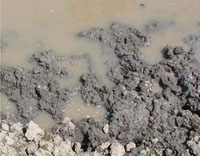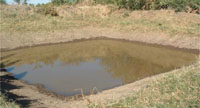
In this section, we summarise the environmental control measures that will be most useful and appropriate in dealing with common mosquito breeding sites.
The construction of roads often leads to the creation of water collections that serve as vector breeding grounds. It often prevents natural drainage of the land and may result in the formation of large ponds alongside the roads.
Control measures include:
Borrow-pits are used to extract soil and stones for construction. Older pits containing vegetation and freshly dug pits collecting rain water (figure below) can serve as very important vector breeding sites.

Control measures include:
Micro-ponds are used to harvest rain water for horticulture and small scale irrigation. There are several types of micro-ponds in use. Some are lined with plastic sheet to prevent seepage and some are covered to avoid evaporation. The plastic lining prevents vegetation growth, making it unfavourable for mosquito breeding; covering the ponds denies access to egg-laying mosquitoes. However, many micro-ponds are neither lined nor roofed and serve as very important vector breeding grounds. Moreover, the location of these ponds very close to houses makes them extremely dangerous sites in terms of malaria transmission.
Control measures include:

Mosquitoes breed in quiet places close to the banks of rivers and creeks where there is protection from currents by obstacles, protruding roots, plants and so on. Effective control of larvae is generally difficult because of the large areas to be covered. Careful study is required to find out the exact location of the breeding sites. During the dry season mosquitoes may breed in stagnant pools in river beds.
Control measures include:
Many development-linked activities (e.g. irrigation) lead to environmental changes and often inadvertently increase the risk of malaria transmission. Appropriate safeguards and actions to reduce the risk are required in the planning, construction, and maintenance phases of development projects. Irrigation canals should be lined and the vegetation cleared to discourage breeding in the canal edges and allow free flow of water. The intervals between releasing a gush of water from an upstream dam can be adjusted to ensure adequate periodic flushing of larvae from pools in the canal beds.